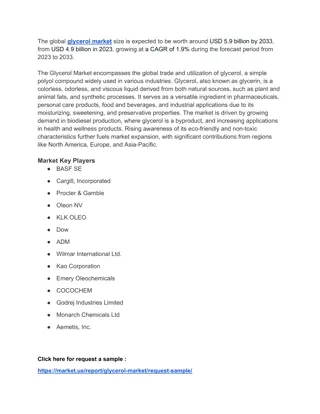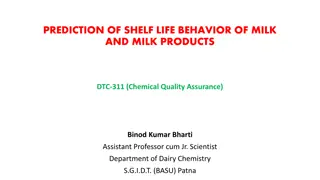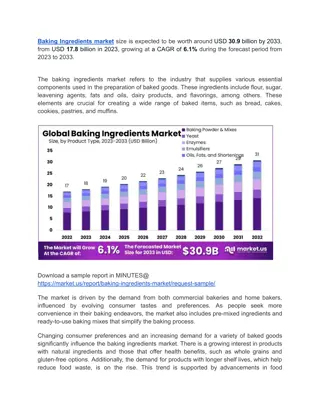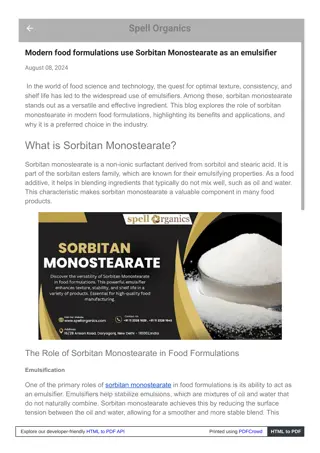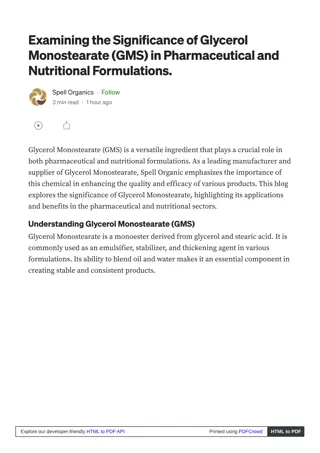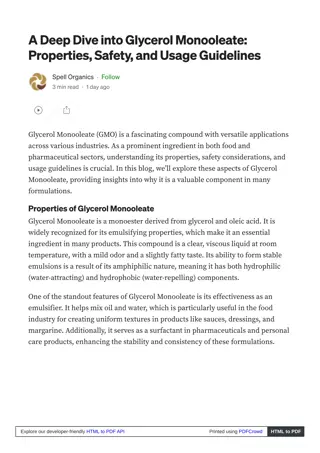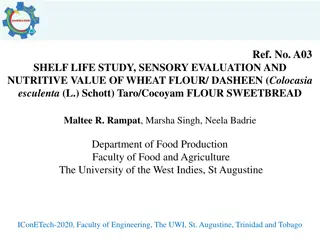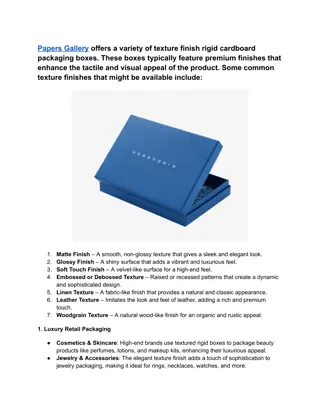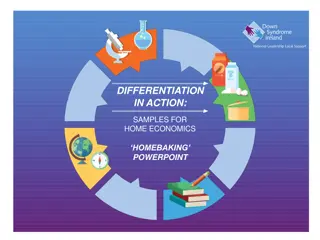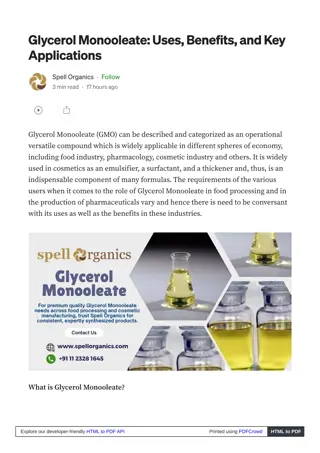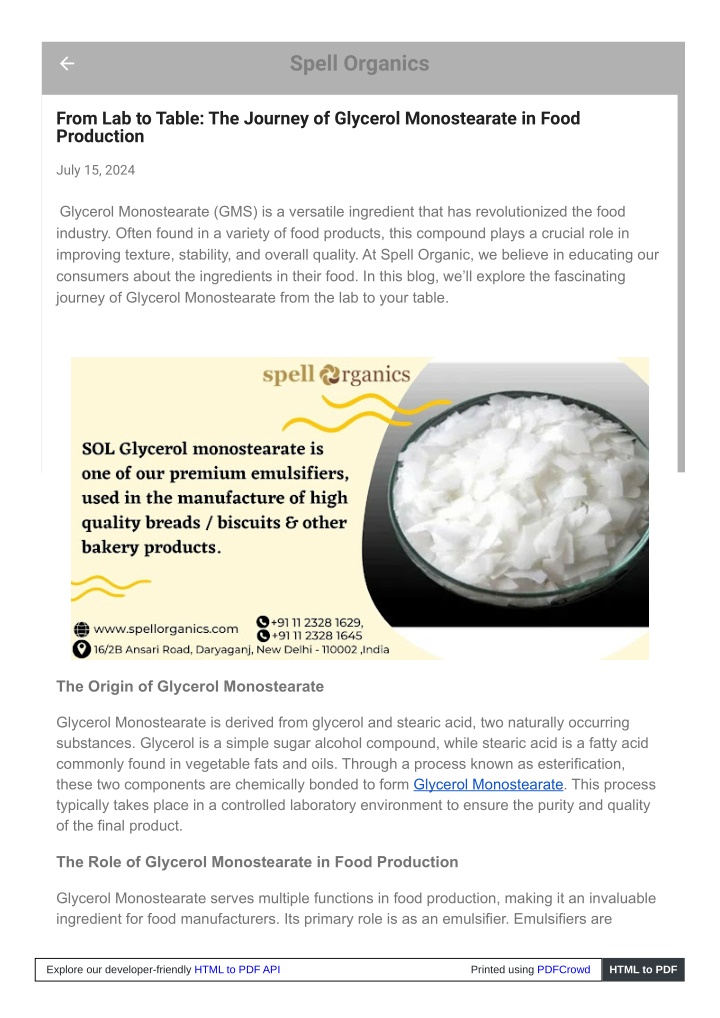
Enhancing Texture and Extending Shelf Life in Baking with Glycerol Monostearate
Glycerol Monostearate (GMS) is a versatile ingredient in baking, known for enhancing texture and extending shelf life. By acting as an emulsifier, Glycerol Monostearate (GMS) helps to improve the consistency and stability of dough and batter, resulti
Download Presentation

Please find below an Image/Link to download the presentation.
The content on the website is provided AS IS for your information and personal use only. It may not be sold, licensed, or shared on other websites without obtaining consent from the author. If you encounter any issues during the download, it is possible that the publisher has removed the file from their server.
You are allowed to download the files provided on this website for personal or commercial use, subject to the condition that they are used lawfully. All files are the property of their respective owners.
The content on the website is provided AS IS for your information and personal use only. It may not be sold, licensed, or shared on other websites without obtaining consent from the author.
E N D
Presentation Transcript
Spell Organics From Lab to Table: The Journey of Glycerol Monostearate in Food Production July 15, 2024 Glycerol Monostearate (GMS) is a versatile ingredient that has revolutionized the food industry. Often found in a variety of food products, this compound plays a crucial role in improving texture, stability, and overall quality. At Spell Organic, we believe in educating our consumers about the ingredients in their food. In this blog, we ll explore the fascinating journey of Glycerol Monostearate from the lab to your table. The Origin of Glycerol Monostearate Glycerol Monostearate is derived from glycerol and stearic acid, two naturally occurring substances. Glycerol is a simple sugar alcohol compound, while stearic acid is a fatty acid commonly found in vegetable fats and oils. Through a process known as esterification, these two components are chemically bonded to form Glycerol Monostearate. This process typically takes place in a controlled laboratory environment to ensure the purity and quality of the final product. The Role of Glycerol Monostearate in Food Production Glycerol Monostearate serves multiple functions in food production, making it an invaluable ingredient for food manufacturers. Its primary role is as an emulsifier. Emulsifiers are Explore our developer-friendly HTML to PDF API Printed using PDFCrowd HTML to PDF
substances that help mix ingredients that typically do not blend well, such as oil and water. By stabilizing these mixtures, Glycerol Monostearate helps maintain the desired consistency and texture of various food products. 1. Enhancing Texture and Consistency: One of the main reasons Glycerol Monostearate is widely used in the food industry is its ability to improve the texture of products. In baked goods, for example, GMS helps to create a smoother and softer texture by interacting with the starch and protein components. This results in bread and cakes that are more tender and have a longer shelf life. 2. Improving Shelf Life: Glycerol Monostearate also plays a significant role in extending the shelf life of food products. By stabilizing emulsions and preventing the separation of ingredients, it helps maintain the quality and freshness of items such as margarine, ice cream, and salad dressings over time. 3. Enhancing Mouthfeel: In addition to its textural benefits, Glycerol Monostearate contributes to the mouthfeel of various foods. In dairy products like ice cream, GMS helps achieve a creamy and smooth texture, making the eating experience more enjoyable. The Application Process in Food Manufacturing In food production, the application of Glycerol Monostearate is both an art and a science. The precise amount of GMS required can vary depending on the product being made. Food scientists carefully measure and incorporate GMS into recipes during the mixing process. This ensures that it is evenly distributed throughout the product, achieving the desired effects. For instance, in the production of margarine, GMS is added during the emulsification stage. It helps create a stable blend of oil and water, resulting in a spread that is smooth and easy to use. In ice cream production, GMS is mixed with other ingredients before the freezing process to ensure a consistent and creamy texture. The Final Product: From Factory to Table Once the food products have been manufactured, they undergo rigorous quality control tests to ensure that they meet safety and quality standards. Products containing Glycerol Monostearate are no exception. These tests verify that the GMS has effectively performed its role in enhancing texture, stability, and overall quality. After passing quality control, the finished products are packaged and distributed to retailers, eventually making their way to your table. Thanks to Glycerol Monostearate, you can enjoy foods that are not only delicious but also have the ideal texture and consistency. Conclusion The journey of Glycerol Monostearate from the lab to your table is a testament to the incredible advancements in food science. At Spell Organic, we recognize the importance of Explore our developer-friendly HTML to PDF API Printed using PDFCrowd HTML to PDF
such ingredients in delivering high-quality food products. Glycerol Monostearate continues to be a key player in the food industry, enhancing the texture, stability, and overall quality of countless items we enjoy every day. As consumers, understanding the role of GMS in our food can help us make more informed choices about the products we purchase and consume. Glycerol Monostearate Popular posts from this blog High-Quality Polyglycerol Polyricinoleate (PGPR) from Spell Organics: Leading Manufacturers and Supplier in India May 07, 2024 Polyglycerol Polyricinoleate (PGPR) is an essential food emulsi?er that is widely used in the food industry to improve the texture and consistency of chocolate products. The demand for PGPR has been increasing over the years, making it vital to choose a READ MORE Glycerol Monostearate Manufacturer and Supplier in India: Quality You Can Trust From Spell Organics June 18, 2024 Glycerol monostearate, commonly known as GMS is a versatile ingredient used across various industries, including food, cosmetics, and pharmaceuticals. When it comes to sourcing high-quality glycerol monostearate (GMS), a trusted manufacturer READ MORE Explore our developer-friendly HTML to PDF API Printed using PDFCrowd HTML to PDF



